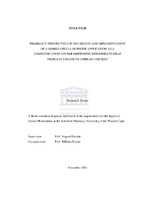| dc.description.abstract | South Africa's White Paper for the transformation of the health care system in South Africa (DOH, 2007) acknowledges major disparities and inequalities as a result of an imprint by apartheid policies. In its transition to democracy, health promotion strategies have been initiated to address these disparities. However, such strategies have been narrowed and "favoured target audiences that are literate, urban-based and who have easy access to print and audio-visual media" (DOH, 1997). This implies that many vulnerable and marginalised groupings in South Africa, including the Deaf community are excluded from health promotion endeavours. Deaf people in South Africa communicate using South African Sign Language (SASL) and majority of the Deaf community exhibit poor literacy levels. Deafness is a significant communication barrier which limits a Deaf person's prospect to attain the best possible health care (Barnett, et al 2011). Various means of communication including spoken language, written instructions and the use of pictograms are used by healthcare workers to communicate health-related information. For many members of the Deaf community who communicate primarily in sign language, these methods are a sub-standard and prevent the attainment of optimum therapeutic outcomes. With regard to pharmaco-therapeutic services, Deaf people cannot hear the spoken language used by pharmacists during patient counselling, and their compromised functional literacy hinders the ability to read instructions on medicine labels. With both the spoken and written means of communication compromised, the Deaf patient's ability to comprehend instruction by pharmacists on how to use their medicines is inadequate and as a result, a Deaf patient may leave the pharmacy with medicine, but a poor understanding of how to use the medicine safely and effectively. Previous researchers have worked on building a technology base, including industrial design and computer science expertise to conceptualize the groundwork of a mobile phone application called SignSupport to facilitate communication between medical doctors and Deaf individuals. The particulars of the pharmacy scenario however, require a pharmacy-specific device to be of use in the dispensing of medicines to a Deaf patient in a pharmacy. The over-arching goal of this thesis is to design and evaluate a mobile phone application to facilitate the communication of medicine instructions between a Deaf patient and a pharmacist. Qualitative, participatory action research and community-based co-design strategies were directed toward Deaf participants, senior pharmacy students and pharmacists to create a prototype of the afore-mentioned mobile phone application. Preliminary results indicated that the application was suitable to pharmacists and Deaf community. Furthermore, both sets of users approved the overall design and were receptive to and keen on the practical uses of the application. Inadequacies pointed out by the Deaf community and pharmacists were addressed as an iterative modification to the prototype and culminated in version 2 which was deployed in an actual hospital pharmacy in 2015. Hospital usability studies generated largely positive results from both Deaf users and pharmacists, indicating that SignSupport is able to facilitate communication between pharmacists and Deaf patients. Next steps include advancing the application to a market–ready version that is downloadable and available as an application on the play stores of commercially available smart phones. | en_US |

